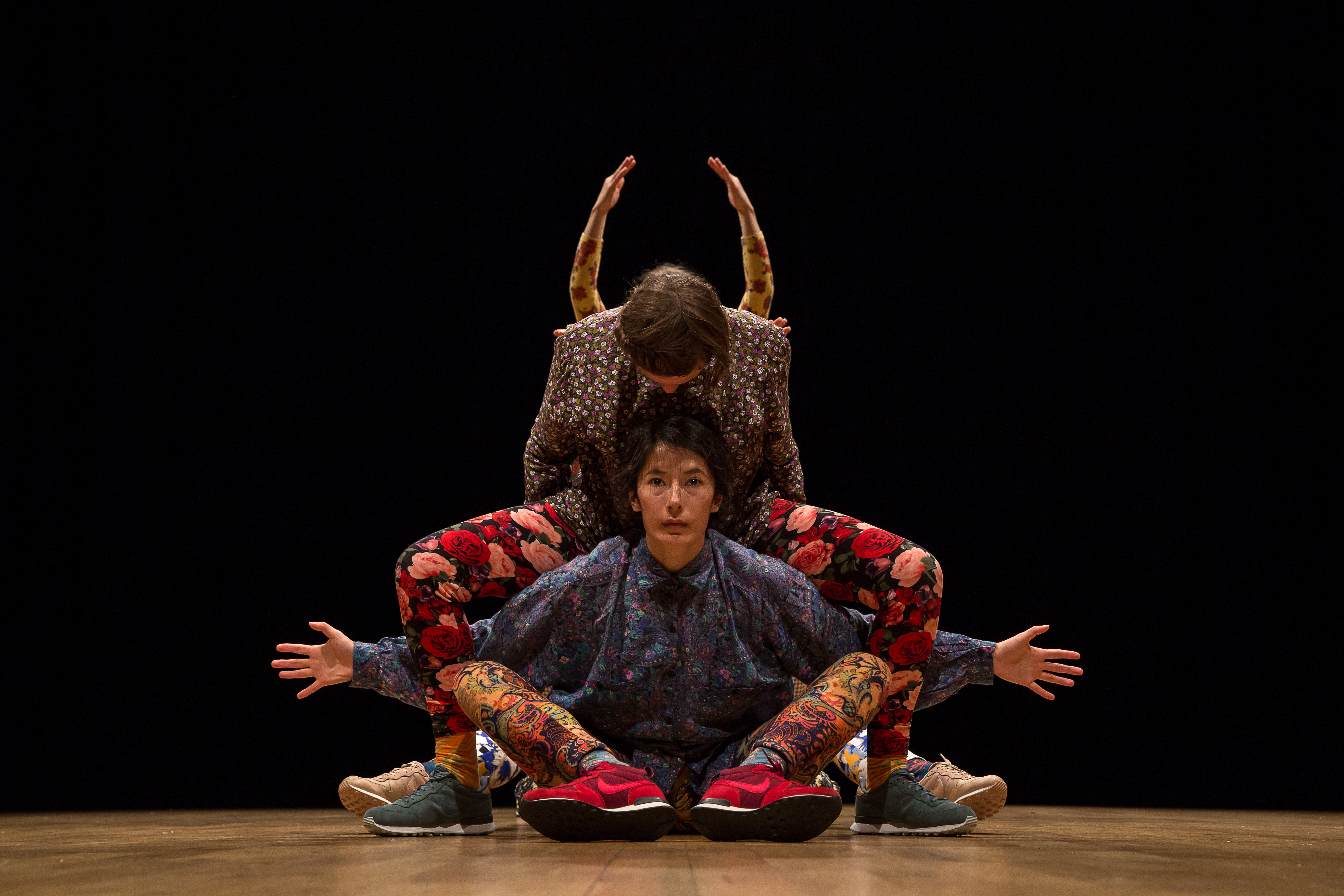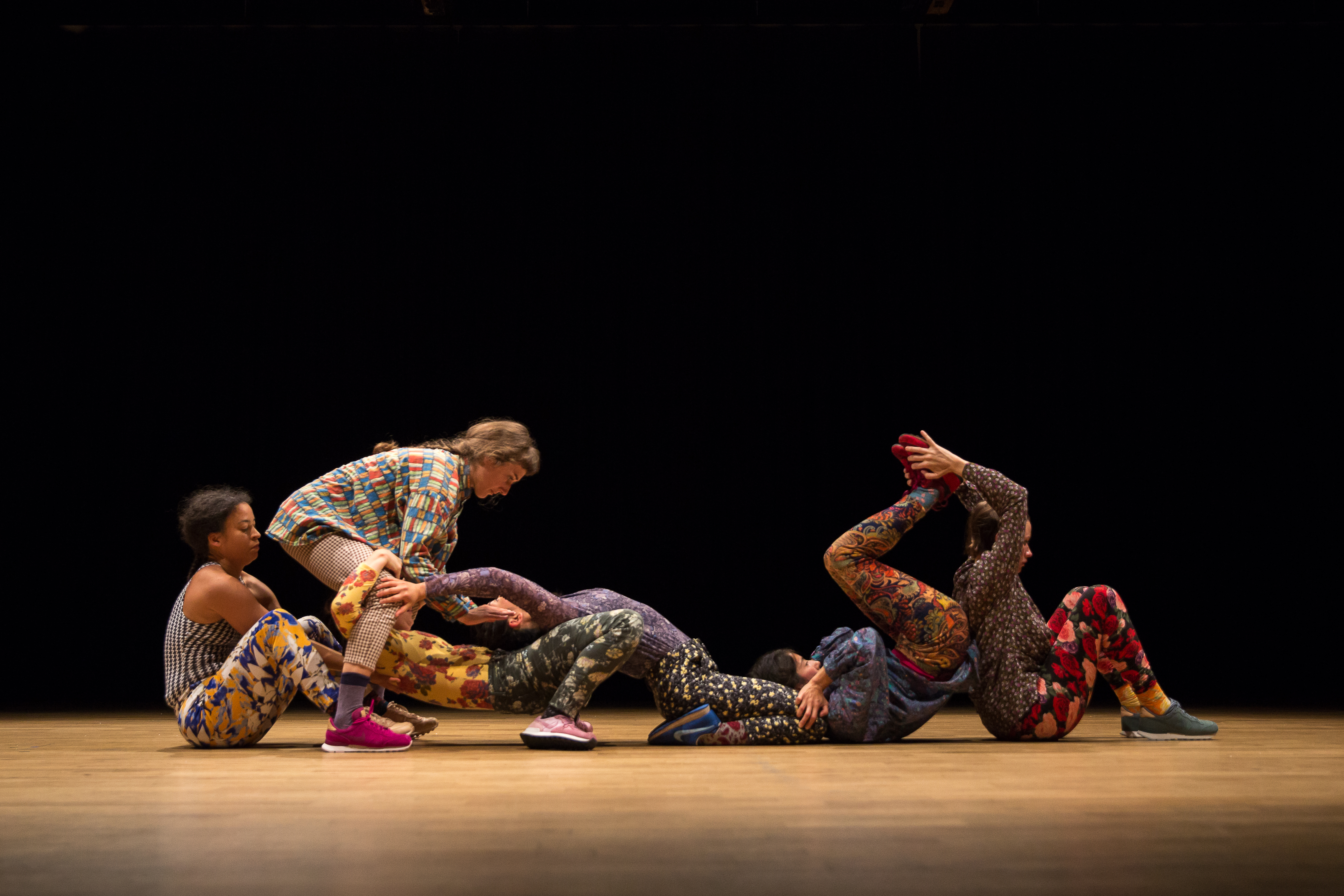Words by Adam Moore.
Shoryuuuuu-ken!!! The year is 1996 and Dark Ryu is gearing up to obliterate me in an unstoppable, mathematical equation that only the PlayStation really understands. All I can do is watch the mesmerising combo lock me in and await my fate. The same feeling of giddy oblivion rises as I watch the Screensaver creep, crawl, push, signal; yield, flex, hold, stroke; reappear and reabsorb itself, in seemingly perfect symmetry, while observing a rhythm, scale and pace that traverses the granular to the grandiose.
The Screensaver Series by J Neve Harrington is not dated or as simple as the title might suggest. Watching the all-female ensemble of six (including Harrington), is like watching an intelligent interplanetary, serpentine lifeform mechanically glide through outer space to land blow after blow on the dorsolateral prefrontal cortex of my brain: it is mesmerising, and it packs a punch — K.O.!!!
The performers’ faces amidst the accumulating symmetrical tangents of their interlocking bodies are stoic and assured. Depth perception distorts as the Screensaver ploughs linear through the air. Faces become abstractions, stacking up, hovering over, bursting through unexpectedly, before vanishing just as quickly. Careful not to knock their heads, I wonder where six skulls nestle in all the motion, protected yet so mobile? The performers’ costumes retain a utilitarian quality within a composition of clashing, pretty patterns, reminiscent of Damien Hirst’s kaleidoscopic butterfly paintings, adding a playful uniformity to the dizzying aesthetic of Screensaver. The skin of the Screensaver is like the spacesuit that Yinka Shonibare’s Refugee Astronaut standing in stasis on the other side of the wall in the Wellcome Collection gallery.
There are some precarious moments in the dance. Weight bearing, strength and tension have their place as features of the choreography. You might sense or see slight glimpses of struggle, but negotiation and intuitive collaboration are foregrounded. I wonder about the coming elections. Politics is a machine, always moving, never stopping, with cold logic that never quite makes sense to me. At points of instability and tension, perhaps a series of inexplicable, granular motions could land us somewhere vastly different, better, maybe: a more connected, more nimble mass? Time will tell.
The sound running parallel to the choreography, reminiscent of Ryoji Ikeda’s Data Matrix, is rhythmically seductive, but warmer, soothing. Jamie Forth composes a neatly structured, improvised score, blanketing the space in modulating textures, coherently translating the choreography into the aural field. Waves, or perhaps wind, rushes in, filling the space as the dancers take off. Arms, legs, backs, hands; feet, fingers, torsos, heads. All behave in a strange geometry. Screensaver bathes the eyes, the ears, and boggles the mind.
Audio visually the Screensaver delights: the flower-power, brightly patterned, geometric prints; the diversity of the cast; the potentially limitless possibilities of movement, and the energy generated by gestures resonating in the sound, bathes the body and boggles the mind. Extremely satisfying is the attack and release – the throb of the work – punctuated by each dancers’ individual cadence. The rapid and well-timed gesticulations, occasionally rattled off in quick successive flurries by Rosalie Pearce Bell, are especially hypnotising. The ensemble simultaneously whirs into pulsing tentacular totems; just as easily, the dance concertina’s back in on itself, hovering just above the ground. The dancers pass efficiently over and under, creating the illusion of passing through.
In Ian McEwan’s short story Solid Geometry, a successful ad-executive stumbles upon curious discovery. Folding a piece of paper along certain vectors and in certain planes, in such a way that it disappears, Phil uses this same technique when making love to his wife, Maisie, who vanishes. We never learn where. Harrington’s Screensaver feels like the inverse: seemingly from nowhere something hidden powerfully manifests.
The strength of this work lies in the level of invention accrued by the ensemble and their ability to focus their attention on allowing their awareness to shift between individual and collective symmetries, and express these through sustained, skilled embodiment, for the duration of the performance. This strength is refracted through sound and amplified through costume design. Positioning the work centrally and inviting audiences to move during the performance, presented audiences with a 360-degree locus around the performance, heightening the queer and beautiful gravity emanating from the centre of the mass of bodies — it was also a welcome gesture that supported a democratic negotiation of viewing space that helped to see the work more clearly.
Harmoniously balancing sound, choreography, and the spatial relations of a softly shifting satellite audience, the link between screensavers and idle time quickly becomes obsolete: The Screensaver Series explodes all the neuroaesthetic boxes, with cushions scattered around to soften the blows.

Images: Roswitha Chesher.
Follow us on Insta: @danceartjournal
